15th–16th Century
The term “free imperial city” (Reichsstadt) was coined in the fifteenth century, but the concept had roots extending back for centuries. Such cities were free from any territorial lord, secular or religious. They answered only to the emperor, who in turn granted the cities special privileges such as the right to mint coins, organize militias, and, most importantly, collect taxes and hold market fairs. Tied to vast commercial networks, these fairs enabled cities like Augsburg, Nuremberg, and Mainz to become hubs for skilled artisans, who produced luxury goods including books, both printed and handwritten. The development of these cities led to profound changes in patterns of artistic patronage, particularly when it came to making works for the open market. Imperial cities proudly proclaimed their status through a variety of visual media, from seals to public monuments. Their wealthy families competed with one another for attention in civic and religious arenas, all of which spurred artistic innovation and rivalry. Commerce and creativity went hand in hand.

